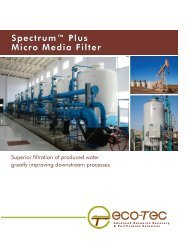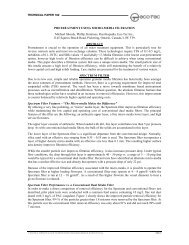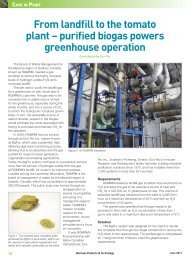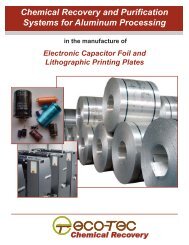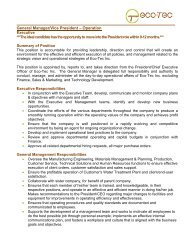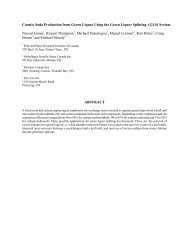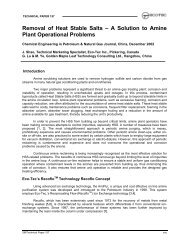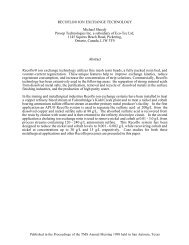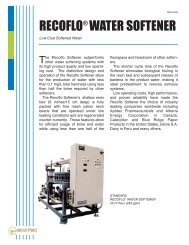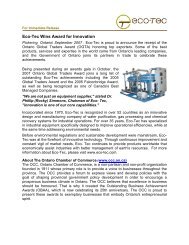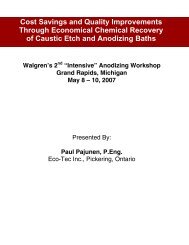(AmiPur®) – Continuous Heat Stable Salts Removal from Amine ...
(AmiPur®) – Continuous Heat Stable Salts Removal from Amine ...
(AmiPur®) – Continuous Heat Stable Salts Removal from Amine ...
Create successful ePaper yourself
Turn your PDF publications into a flip-book with our unique Google optimized e-Paper software.
<strong>Amine</strong> Purification System (AmiPur®) – <strong>Continuous</strong> <strong>Heat</strong> <strong>Stable</strong> <strong>Salts</strong> <strong>Removal</strong><br />
<strong>from</strong> <strong>Amine</strong> Solutions<br />
1. Introduction<br />
Jenny Shao, Group Leader – Oil & Gas, Eco-Tec Inc. Canada<br />
<strong>Amine</strong> scrubbing solutions are used to remove hydrogen sulfide (H 2 S) and carbon<br />
dioxide (CO 2 ) <strong>from</strong> gas streams and LPG in many oil refineries and natural gas<br />
conditioning plants. Due to its high selectivity to H 2 S, Methyldiethanolamine (MDEA) is<br />
most commonly used to remove H 2 S in the presence of CO 2 <strong>from</strong> gas streams and LPG.<br />
<strong>Amine</strong> plant operational problems, such as excessive foaming, corrosion, and capacity<br />
reduction, are often attributed to the accumulation of amine heat stable salts. These heat<br />
stable salts lead to costly maintenance problems such as corrosion, frequent filter<br />
replacement, foaming in the absorber column, absorber tower plugging, heat exchanger<br />
fouling and a reduction in the amount of amine available for gas treating.<br />
<strong>Continuous</strong> amine purification is being increasingly recognized as the most effective<br />
solution for HSS related problems. The benefits of continuous HSS removal go beyond<br />
limiting the level of impurities in the amine loop. A continuous on-line purification<br />
system helps to ensure a stable and uniform gas conditioning operation where<br />
contaminant level in the amine solution is prevented <strong>from</strong> building up, thus minimizing<br />
the rate of corrosion. It also ensures that amine unit operation is reliable and provides the<br />
designed gas treating efficiency.<br />
Developed by Eco-Tec Inc. Canada in 1998, AmiPur® (<strong>Amine</strong> Purification System) uses<br />
anion exchange technology to continuously remove heat stable salts. Therefore, it ensures<br />
reliable operation of amine plant.<br />
2. AmiPur® – <strong>Heat</strong> <strong>Stable</strong> Salt <strong>Removal</strong> System<br />
Eco-Tec AmiPur® employes its Reciprocating Flow (Recoflo TM ) ion exchange<br />
technology, which has been extensively used since 1973 in many chemical recovery and<br />
water treatment systems. The AmiPur®, a unique and cost effective on line amine<br />
purification system has the following features:<br />
• Fine particle size resins;<br />
• Countercurrent regeneration;<br />
• Short column heights (12 inch, 30 cm);<br />
• Low resin loading;<br />
• Fast flows and short cycles;<br />
These on-line Eco-Tec <strong>Amine</strong> Purification (AmiPur®) systems are now successfully<br />
operating in 25 petroleum refineries and natural gas plants in 10 countries worldwide,<br />
Table 1.
Table 1. AmiPur® user’s list<br />
Customer<br />
Crown Central Petroleum Corp.<br />
Motiva Enterprises LLS<br />
Shell Opus<br />
Conco Phillips<br />
Sunoco Mid-America<br />
Torch Energy Marketing<br />
Duke Energy<br />
Marathon Ashland Petroleum<br />
Tampa Electric/Polk Power Plant<br />
Marathon Ashland Petroleum<br />
Petrox S.A.<br />
Lyondell-CITGO Refining Company<br />
La Gloria<br />
Nerefco – Europort<br />
Reliance Petroleum – Jamnager Complex<br />
Amoco (BP) Sharjah Oil Company<br />
Sinopec Zhenhai<br />
Praxair Inc.<br />
P.T. Susila – Krakatau Steel<br />
Enbridge Pipelines LP<br />
San Nazzaro Gasification Plant – Snamprogetti<br />
Vintage Petroleum Inc.<br />
PXP/DCOR<br />
SINCOR<br />
Valero Aruba Refining<br />
Location<br />
Pasadena, Texas, USA<br />
Port Arthur, Texas, USA<br />
Bakersfield, California, USA<br />
Ferndale, Washington, USA<br />
Toledo, Ohio, USA<br />
Snyder, Texas, USA<br />
Hallettsville, Texas, USA<br />
Garyville, Louisiana, USA<br />
Mulberry, Florida, USA<br />
Robinson, Illinois, USA<br />
Talcahuano, CHILE<br />
Houston, Texas, USA<br />
Tyler, Texas, USA<br />
NETHERLANDS<br />
Gujarat, INDIA<br />
Sharjah, UNITED ARAB EMIRATES<br />
Zhejiang, CHINA<br />
Texas City, Texas, USA<br />
Jakarta, INDONESIA<br />
Texas, USA<br />
San Nazzaro de Burgondi, ITALY<br />
California, USA<br />
California, USA<br />
VENEZUELA<br />
ARUBA<br />
Eco-Tec offers seven different models of AmiPur®, with different HSS removal capacity.<br />
A typical AmiPur® unit is presented at Figure 1.<br />
There are basically two steps in the AmiPur® operating cycle: amine loading and caustic<br />
regeneration. This cycle is automatically repeated every 10-15 minutes.<br />
Lean amine solution is pumped through a cartridge filter and into the resin column. The<br />
ion exchange resin removes the heat stable salts and the purified amine solution is<br />
directed to the flash tank or returned into the amine batch.<br />
Loading step: R’OH + RN 3 + HHCOO -<br />
R’HCOO + RN 3 + H 2 O<br />
During caustic regeneration step, dilute caustic soda is used to regenerate the resin<br />
column. The unit draws concentrated caustic <strong>from</strong> tanks or drums and dilutes it to the<br />
proper strength automatically.
Regeneration step: R’HCOO + NaOH<br />
R’OH + HCOONa<br />
Note: R’OH – resin surface, RN 3 – tertiary amine, HCOOH - HSS<br />
Figure 1. Skid mounted AmiPur® unit<br />
With the same HSS removal capacity, AmiPur® has the following advantages over other<br />
amine purification systems using ion exchange technology,<br />
• AmiPur® uses the least amount of NaOH for regeneration;<br />
• AmiPur® generates the least amount of waste;<br />
• AmiPur® uses the least amount of resin;<br />
• AmiPur® has the least amine loss;<br />
• AmiPur® has the smallest skid size.
3. Case Study I: Crown Central Petroleum Corporation (CCPC), USA<br />
The amine unit in CCPC contains a gas liquid contactor or fuel gas absorber, a liquidliquid<br />
C3/C4 amine treater, one amine regenerator a flash drum, heat exchangers, amine<br />
filters, a slip stream amine reclaimer, and several associated pumps.<br />
The main fuel gas absorber is a packed column with 2 beds of random packing and<br />
demister type separation at the top gas outlet. The lean amine feeds the top bed of<br />
packing through a distributor and flows down the column, contacting the sour fuel gas<br />
and removing the H 2 S. The sour gas enters the bottom of the column above the tower’s<br />
rich amine liquid level. The tower’s pressure drop is measured over inlet gas line to outlet<br />
gas line, and this pressure drop is used to monitor tower pluggage and foaming.<br />
The liquid-liquid amine contactor is a trayed tower with 15 trays. This tower also serves<br />
as an amine surge tank, since about 80% of the amine unit inventory is kept in this tower.<br />
The tower is designed to remove about 1000 ppm H 2 S <strong>from</strong> 21,000 BPD C3/C4 mix.<br />
The tail gas unit’s amine system is very similar to the main amine system, with no flash<br />
drum and only a single amine absorber.<br />
As HSS build, the amine filters plugged more frequently. Iron in the solution started to<br />
climb. <strong>Heat</strong> exchanger surfaces became fouled forcing the operator to increase the energy<br />
input to the unit’s regenerator reboiler. Tower internals became fouled, increasing<br />
velocities and pressure drop to the point of increasing the overall amine losses. The<br />
amine solution itself started to “foam” more easily due to the increase of impurities in the<br />
solution, and an rapid changes in absorber feed rates caused amine carryover, amine<br />
losses, tower instability, potentially poor H 2 S treat, environmental non-compliance, and<br />
sulfur plant upsets.<br />
AmiPur® Operation at CCPC<br />
At Crown Central Petroleum’s Pasadena, Texas refinery, an AmiPur® unit was installed<br />
in 1998 to effectively remove HSS <strong>from</strong> MDEA solution. The unit was started up in<br />
October 1998.<br />
The HSS in solution were at approximately 2.4 wt% (as MDEA) when the AmiPur® unit<br />
was started up, and within 30 days the HSS went down to less than 2 wt.%. Material that<br />
had been accumulated <strong>from</strong> the amine unit prior to installation with HSS level of 3.5<br />
wt.% was then introduced back into the process. The HSS level in the solution increased<br />
back to 2.4 wt.%.<br />
By March 1999, after a unit shut down for maintenance and a replacement of the amine<br />
regenerator tower, the HSS level was down to 1.75 wt.%. A significant decrease in<br />
corrosion rate was observed. The ultimate goal of the refinery is to keep corrosion rate as<br />
close to zero as possible. To achieve this goal, it was decided to decrease the HSS
concentration further, <strong>from</strong> 1.5 wt.% to 0.5 wt.%, so the unit was upgraded with extra<br />
capacity. Figure 2 is the curve of the heat stable salt decline.<br />
Due to the decrease in HSS level, corrosion probe readings, which had been as high as<br />
160 mpy before, now average less than 10 mpy. As shown in Figure 3, since year 2001,<br />
the readings have always been close to zero.<br />
As shown in Figure 4, filter change frequency decreased <strong>from</strong> more than 10 times per<br />
month to average once per month.<br />
Due to more stable operation, less filter change, and less foaming, annual amine purchase<br />
has been decreased <strong>from</strong> 200,000 pounds in 1998 to about 50,000 pounds since year 2000,<br />
see Figure 5.<br />
Figure 6 shows that the total hours H 2 S out of compliance each year decreased <strong>from</strong><br />
hundreds of hours each year (even more than one thousand hours sometimes) to less than<br />
50 hours ( sometimes zero 0 hour).<br />
HSS By INEOS<br />
% HSS<br />
6<br />
5<br />
4<br />
3<br />
2<br />
1<br />
0<br />
1997/05/16<br />
1998/04/27<br />
5.46 5.38<br />
4.97<br />
4.4<br />
3.76<br />
2.95<br />
2.62<br />
2.16 2.13<br />
2.14<br />
1.86 1.88<br />
1.62<br />
1.49 1.59<br />
1.77<br />
1.311.2<br />
1.15<br />
0.82 0.71<br />
0.49<br />
0.42 0.41 0.27 0.28 0.42 0.56 0.42 0.5 0.34<br />
0.53<br />
0.69 0.73 0.6 0.77 0.998<br />
0.701 0.598 0.62 0.71 0.8352<br />
0.6309 0.6153<br />
0.34 0.25 0.26 0.28 0.22 0.28 0.41 0.3962<br />
0.5755 0.7151 0.6368 0.5565<br />
0.2978<br />
1998/11/23<br />
1999/04/26<br />
1999/08/23<br />
2000/01/03<br />
2000/05/15<br />
2000/09/25<br />
2001/03/19<br />
2001/07/30<br />
DATE<br />
2002/02/26<br />
2002/07/29<br />
2002/12/02<br />
2003/07/28<br />
2004/01/23<br />
Figure 2. HSS level at the main amine unit at CCPC Pasadena refinery.
MONTHLY MPY<br />
120<br />
100<br />
102<br />
108<br />
103<br />
100<br />
80<br />
84<br />
87<br />
85<br />
81<br />
75<br />
60<br />
48<br />
50 51 50<br />
53<br />
40<br />
33<br />
40<br />
37<br />
28<br />
27<br />
MONTHLY MPY<br />
20<br />
0<br />
May 97 Ave<br />
Dec 97 Ave<br />
July 98 Ave<br />
20<br />
17 17 17 15<br />
1313 12<br />
10<br />
4 5 5 65<br />
1 1 23 46 4 7 4<br />
2111 00000000000000000 00000000000000000<br />
Feb 99 Ave<br />
Sept 99 Ave<br />
Apr 00 Ave<br />
Nov 00 Ave<br />
July 01 Ave<br />
Apr 02 Ave<br />
Nov 02 Ave<br />
July 03 Ave<br />
Feb 04 Ave<br />
Figure 3. Corrosion probe readings at CCPC Pasadena refinery.<br />
Filter Changes Per Month<br />
# Changes per Month<br />
15<br />
10<br />
5<br />
0<br />
11 11<br />
Ave<br />
97<br />
Ave<br />
98<br />
2.6<br />
Ave<br />
99<br />
1.1 1 2.1<br />
Ave<br />
00<br />
Ave<br />
01<br />
Ave<br />
02<br />
0.8 1<br />
Ave<br />
03<br />
Ave<br />
04<br />
Figure 4. Filter changes per month at CCPC Pasadena refinery.
<strong>Amine</strong> Purchases<br />
Pounds MDEA<br />
500000<br />
450000<br />
400000<br />
350000<br />
300000<br />
250000<br />
200000<br />
150000<br />
100000<br />
50000<br />
0<br />
1992<br />
Purchases<br />
1994<br />
Purchases<br />
1996<br />
Purchases<br />
1998<br />
Purchases<br />
2000<br />
Purchases<br />
2002<br />
Purchases<br />
Figure 5. Annual amine purchase at CCPC Pasadena refinery<br />
Total Hours H2S Out Of Compliance<br />
2500<br />
2000<br />
2037<br />
1938<br />
1500<br />
1166<br />
1000<br />
500<br />
504<br />
420<br />
525<br />
0<br />
55 21 0 30 10 0<br />
1993 1994 1995 1996 1997 1998 1999 2000 2001 2002 2003 2004<br />
Figure 6. Total Hours H 2 S out of Compliance at CCPC Pasadena refinery
4. Case Study II: SINOPEC Zhenhai refinery, China<br />
Problems in #2 catalytic cracking/amine scrubbing unit<br />
#2 catalytic cracking unit in Zhenhai refinery, China, has cracking capacity of 3,000,000<br />
Tonne/year. This FCC unit is connected to an amine scrubbing unit using MDEA, which<br />
treats 160,000 Tonne/year of dry gas and 450,000 Tonne/year of LPG. In 2001, treating<br />
capacity of LPG was increased to 600,000 - 700,00 Tonne/year. Major problems with the<br />
amine scrubbing unit are: (1) high concentration of suspended solids, frequent filter<br />
clogging, amine losses due to foaming and equipment fouling (see Figure 7, 9). (2) severe<br />
corrosion problems found in reboiler, higher temperature piping and lean/rich heat<br />
exchanger (see Figure 8). Corrosion was also observed at all connections. On December<br />
5, 2001, leaking in gas piping was found. In July 2002, both inlet and outlet piping and<br />
lean/rich heat exchanger started leaking. In September 2002, the whole unit was shut<br />
down for repair. There was 60 Tonne of 24% dirty amine drained <strong>from</strong> the unit.<br />
AmiPur® operation at Zhenhai refinery<br />
Based on the HSS analysis results shown in Table 2, an Eco-Tec AmiPur® unit (AM15)<br />
was selected to keep the system HSS level below 1 wt.% (as MDEA). There are two<br />
operation modes: hig HSS mode and low HSS mode. The high mode is used to bring<br />
HSS level down to 1 wt.% as fast as possible. The low mode will keep the HSS<br />
concentration in amine solution below 1 wt.%<br />
Table 2. #2 FCC amine scrubbing unit <strong>Heat</strong> <strong>Stable</strong> Salt analysis results in 2001<br />
Date 6.22 6.25 6.26 6.27 6.28 6.29 7.2<br />
HSS,wt% 6.42 6.75 6.76 6.81 6.82 6.90 7.2<br />
The system was installed on August 11, 2003 and started up on August 22, 2003. By<br />
September 6, the system had been running for 2300 cycles at high HSS mode and the<br />
HSS level was brought down <strong>from</strong> 3.8 wt.% to 1.0 wt.%. The system was switched to<br />
low HSS mode and the HSS level in solution has been kept below 1 wt.% (as MDEA),<br />
lowest at 0.27 wt.%, as shown Figure 10.
Figure 7.Lean/rich heat exchanger piping<br />
Figure 8. Reboiler piping<br />
Figure 9. Erosion inside lean/rich heat
HSS l evel<br />
4. 0%<br />
3. 5%<br />
3. 0%<br />
2. 5%<br />
HSS in AmiPur®<br />
i l t<br />
2. 0%<br />
1. 5%<br />
1. 0%<br />
0. 5%<br />
HSS in AmiPur®<br />
tl t<br />
0. 0%<br />
8/ 7 8/ 17 8/ 27 9/ 6 9/ 16 9/ 26 10/ 6 10/ 16 10/ 26 11/ 5 11/ 15<br />
Figure 10. HSS level change in amine solution at Zhenhai refinery, China<br />
Due to the continuous removal of HSS by AmiPur®, system corrosion rate has been<br />
decreased dramatically. Average Corrosion rate at the top of the regenerator before<br />
AmiPur® was 90 mpy as shown in Figure 11. When HSS level was brought down to 0.5<br />
wt.%, the corrosion rate at the top of regenerator is as low as 2 mpy, shown in Figure 12.<br />
When HSS level was 6 wt.% (as MDEA), foam height was 20 cm and break time was 20<br />
seconds. Because of the low HSS level, both foam height and break time in #2 FCC<br />
amine unit are obviously better than other amine units, especially break time, shown in<br />
Table 3.<br />
When the HSS level is lowered, more amine is available for sour gas treating. In Zhenhai<br />
refinery, a 25% of amine saving was realized one month after the start up of AmiPur®.
Figure 11, Corrosion rate before AmiPur®® operation at Zhenhai refinery,<br />
Figure12, Corrosion rate after AmiPur®® operation at Zhenhai refinery, China
Table 3. Comparison of HSS level(wt%),foam height(cm), and break time(s)in<br />
different amine units at Zhenhai refinery, China<br />
Time #2 FCC #1 FCC Delayed coking<br />
HSS Foam height Break<br />
time<br />
HSS<br />
Foam<br />
hetight<br />
Break time HSS Foam height Break time<br />
10.1 0.63 3.5 5 4.62 4.0 12 3.58 5.0 18<br />
5<br />
10.1 0.65 3.0 5 4.65 4.5 10 3.62 5.5 21<br />
6<br />
10.1 0.62 3.5 6 4.69 4.0 12 3.67 5.0 23<br />
7<br />
10.1 0.60 3.5 5 4.76 4.5 13 3.75 6.0 18<br />
8<br />
10.1 0.59 3.0 6 4.88 4.0 11 3.8 5.5 19<br />
9<br />
10.2 0.59 3.5 5 4.95 4.0 12 3.87 5.0 20<br />
0<br />
11.5 0.45 3.5 5<br />
5. Summary<br />
<strong>Amine</strong> degradation causes the formation of heat stable salts (HSS) that can lead to<br />
corrosion. The amine unit performance begins to deteriorate as the HSS level increases,<br />
and the performance absorber and regenerator becomes less stable.<br />
One of the most important results of an AmiPur® installation is the STABLE and<br />
RELIABLE operation of the amine plant, which in turn has a dramatic environmental<br />
impact. The continuous removal of HSS has immediate and easily quantifiable results:<br />
reduction of filtration costs; elimination of periodic chemical cleaning of the absorber<br />
tower; improved gas treating capacity of the unit due to increased amount of amine<br />
available for gas treating; elimination or reduced use of antifoamers, neutralizers and<br />
corrosion inhibitors; elimination of the cost associated with previously used methods of<br />
HSS removal. All AmiPur® installations have demonstrated the benefits of continuous<br />
removal of HSS for both oil refineries and natural gas plants.



